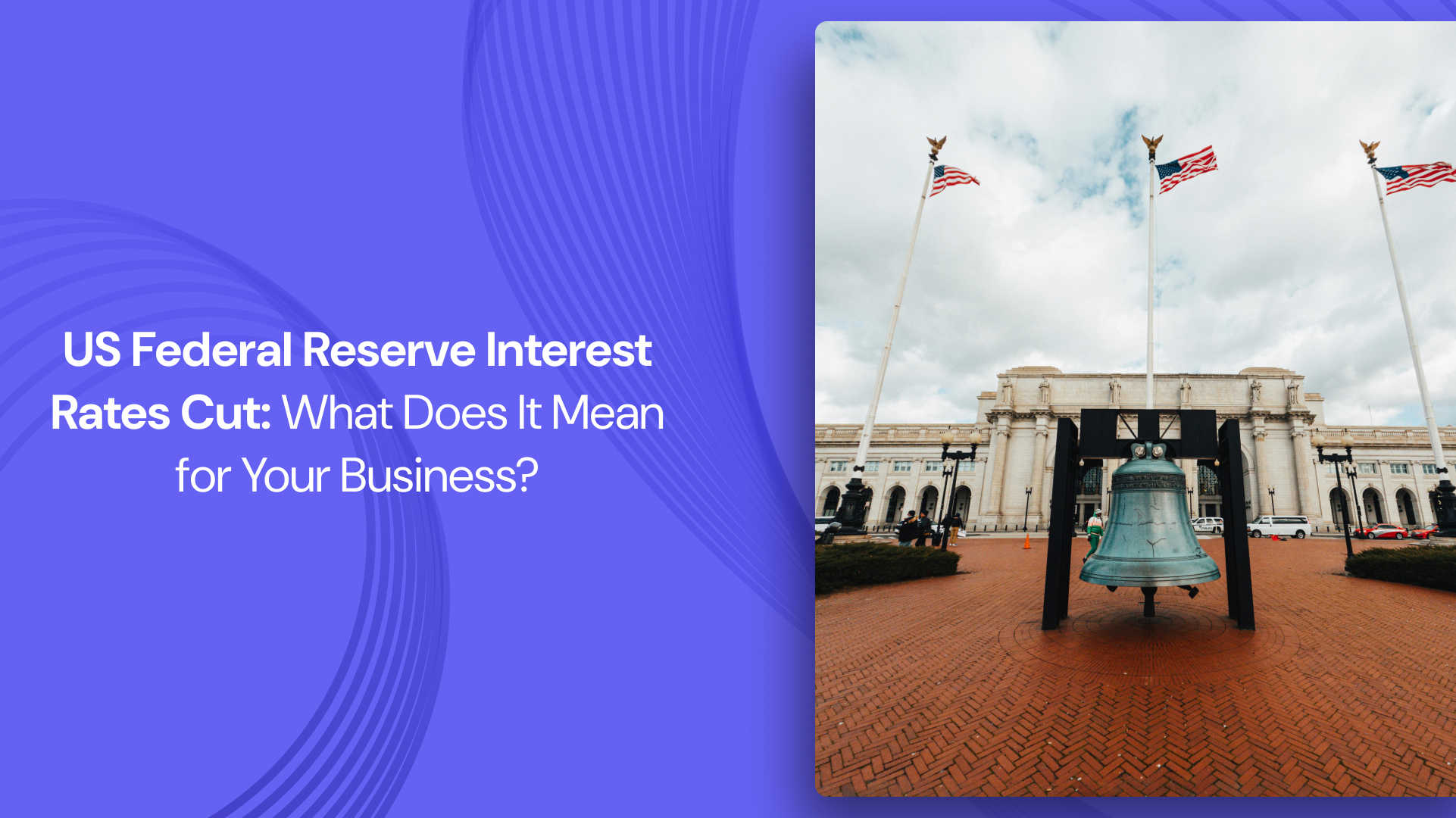US Federal Reserve Interest Rates Cut: What Might It Mean for Your Business?

The U.S. Federal Reserve's decision to cut interest rates by 50 basis points can have a profound impact on businesses of all sizes, particularly small and medium-sized businesses (SMBs). This is because they often end up paying 2-3% higher interest rates on loans compared to larger corporations.
Lower interest rates typically make borrowing more affordable, opening up opportunities for expansion, investment, and improved cash flow management. However, it can also signal economic concerns that businesses need to prepare for.
In this article, we'll explore how the rate cut can influence everything from your financing options to customer demand and risks, and how businesses can manage them.
Understanding the Federal Reserve's Decision
The US Federal Reserve adjusts interest rates to manage the economy, and they have recently cut interest rates by 50 basis points from 5.3% to 4.8% after 2 years of high rates. One of the primary reasons for cutting interest rates is to stimulate economic growth, and considering that it was a major cut, interest rates might continue to dip in the future. Here are a few factors that have influenced the decision-making process.
Why Cut Interest Rates?
- Boost Economic Activity: Lower interest rates make borrowing cheaper, encouraging businesses to invest and consumers to spend. This increased spending can stimulate economic growth and create jobs.
- Combat Recessions: During economic downturns, the Fed may lower interest rates to encourage spending and investment, preventing a deeper recession.
- Prevent Deflation: A decline in the general price level can discourage spending and investment. By lowering interest rates, the Fed aims to increase the money supply and prevent deflation.
How Do Lower Interest Rates Affect Borrowing Costs and Opportunities for Businesses?

One of the most immediate effects of a Federal Reserve interest rate cut is a reduction in business borrowing costs. As the Fed lowers its benchmark interest rate, banks typically follow by reducing their lending rates, which can make business loans more affordable.
This means that small and medium-sized businesses (SMBs) can access capital at a lower cost, enabling them to invest in growth initiatives, such as expanding operations, purchasing equipment, or hiring new staff.
Lower interest rates also provide an opportunity for businesses to refinance existing loans at more favorable terms. It can reduce monthly payments and free up cash flow, allowing businesses to allocate resources to other critical areas like marketing, research, or inventory management.
It also makes lines of credit and other financing options more attractive, providing businesses with a cushion to manage short-term cash flow fluctuations. For companies that rely on credit to bridge gaps between expenses and revenue, this can be a significant benefit, reducing the cost of carrying debt and easing financial pressure.
However, businesses should be mindful of the risks associated with taking on additional debt, even in a low-rate environment. Even though borrowing might be less expensive, it's crucial to make sure you can comfortably service the debt in the event of deteriorating economic conditions or falling revenue projections. It is quite plausible that you overborrow and are unable to continue on payments.
Potential Economic Risks Associated with Rate Cuts

While a Federal Reserve interest rate cut can offer several financial advantages, such as lower borrowing costs and improved cash flow, it can also signal underlying economic uncertainty that businesses need to consider. For small and medium-sized businesses (SMBs), this can present several risks:
1. Reduced Consumer Confidence
If the Fed is cutting rates to stimulate a sluggish economy, it may indicate that consumer confidence is declining. Even with lower borrowing costs, if customers fear an economic downturn, they may reduce spending, delay large purchases, or become more cautious about taking on new debt. For businesses, this means that despite favorable financing conditions, demand for products and services could soften, leading to slower revenue growth.
2. Increased Credit Risk
Lower interest rates can encourage businesses and consumers to take on more debt. While this can drive sales in the short term, it also increases the risk of defaults or payment delays if the economy worsens. If businesses extend too much credit to customers who later face financial difficulties, they could struggle with higher rates of delinquent accounts and bad debt.
3. Inflation Concerns
Though a rate cut is intended to stimulate the economy, it can also stoke inflation if consumer and business demand rebound quickly. Rising inflation can increase operational costs for SMBs, particularly in areas like raw materials, labor, and shipping. If prices rise faster than businesses can adjust, profit margins may be squeezed, especially if they are unable to pass on these costs to customers.
4. Volatility in Financial Markets
Interest rate cuts can also contribute to volatility in financial markets. Stock and bond markets may react unpredictably, and businesses with investments or heavy reliance on market performance could face fluctuating asset values. Additionally, the long-term effects of rate cuts on exchange rates and trade may impact businesses engaged in international trade, either by affecting export demand or making imports more expensive.
5. Long-Term Debt Risk
While borrowing costs are lower in the short term, businesses need to be cautious about taking on too much long-term debt during periods of economic uncertainty. If the economic outlook deteriorates further, businesses with excessive debt may struggle to meet repayment obligations, particularly if revenue declines. It's essential to balance the benefits of cheaper borrowing with the potential for economic conditions to worsen.
Practical Steps Businesses Can Take to Respond to a Lower Interest Rate Environment
In response to a Federal Reserve interest rate cut, it’s crucial for businesses to reassess and adapt their strategies to make the most of the new economic environment. Lower rates can create unique opportunities, but they also come with potential risks that need to be addressed proactively. Here’s how businesses can adjust their strategies:
- Leverage Lower Borrowing Costs for Growth: With reduced interest rates, businesses can access cheaper capital, providing a chance to invest in growth areas. Consider using this opportunity to expand operations, purchase new equipment, or invest in technology and innovation that were delayed due to financing concerns. However, it is important to ensure that you plan conservatively and not delay payments.
- Focus on Customer Retention and Engagement: In times of economic uncertainty, maintaining strong customer relationships is critical. Businesses should focus on customer retention strategies, such as offering loyalty programs, discounts for early payments, or personalized experiences. Engaging more deeply with existing customers can drive repeat business and stabilize revenue during periods of fluctuating demand.
- Reassess Credit Policies: While lower interest rates make it easier to extend credit to customers, it’s essential to strike the right balance. Evaluate your current credit policies to ensure that you’re not overextending credit to clients who may face financial difficulties. Tightening credit approval processes and monitoring customer payment behavior closely can help prevent an increase in delinquent accounts or bad debts.
- Improve Operational Efficiency: With potential risks looming from economic uncertainty, businesses should aim to streamline operations and reduce unnecessary expenses. Implementing automation, optimizing supply chains, and improving internal workflows can help businesses become more resilient and cost-efficient, mitigating any negative impact from reduced consumer demand or inflationary pressures.
- Prepare for Future Economic Shifts: While a rate cut can create short-term opportunities, businesses should also plan for potential long-term economic shifts. Rate cuts are often a sign of broader economic challenges, so businesses should consider building financial buffers, such as emergency funds or revolving lines of credit to weather future downturns. Keeping an eye on broader economic trends and planning for different scenarios can help businesses remain flexible and prepared for future changes.
How Can FinanceOps Help?
FinanceOps can be a powerful ally for businesses looking to navigate the opportunities and challenges presented by a Federal Reserve interest rate cut. Its AI-powered platform, Genesis One, offers solutions that help companies optimize their financial operations, particularly in managing debt and improving cash flow.
FinanceOps’ Autonomous Collections solution can enhance the debt collection process, ensuring businesses recover outstanding receivables more efficiently. Its' AI-powered agent, Alice, automates communications with customers, sending timely reminders, payment follow-ups, and reconciling cash. This minimizes the manual effort involved in collections, reducing overdue accounts, and improving overall cash flow.
Genesis One also brings financial reporting and workflow optimization to help businesses visualize their cash flow and make informed decisions. This allows companies to maintain strong financial health and adapt to the evolving economic landscape.

